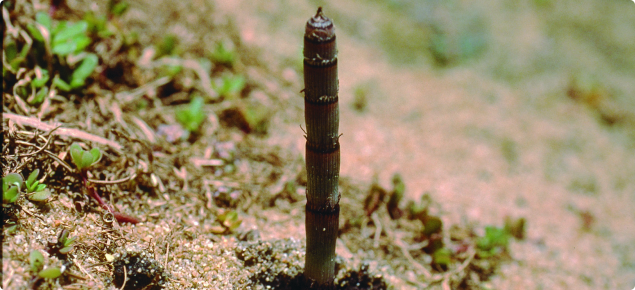Form: herbaceous — perennial
Status: present in WA
Appearance
An erect, non-flowering perennial herb native of Europe, Asia and North America. It has ribbed or grooved annual stems 10-60cm high, and tuber-bearing creeping rhizomes (underground stems). Spreads primarily by rhizomes and root pieces, but also reproduces by spores.
Sometimes cultivated and extremely difficult to eradicate, especially in rocky soils. Grows mainly in damp places. Outbreaks have been controlled following spread from plantings in New South Wales, Victoria, Tasmania and Western Australia. Plants have high silica content and have been used for scouring pots, hence the common name, scouring rush.
Stems: annual, stems can be erect or lay flat on the ground with only the tips being erect. They are jointed and two types are formed. Vegetative stems are green, growing to greater than 50cm high, 1.5-5mm diameter, hollow, with whorls of solid three to four angled branches rising below the cup nodal sheaths.
Fertile stems are whitish, appearing in early spring, growing to greater than 30cm tall and up to eight millimetres in diameter, succulent, unbranched, jointed with sheaths (14-20mm long) around each node, terminating in a long-stalked spore-producing cone. Fertile stems often lack the side branches.
Leaves: reduced to a papery crown of six to 18 scales at each stem joint. Green on the main stem, but often dark brown on lower stem.
Online weed identification training
Login or set up a new account on DAFWAs online training site to access:
- a training course on how to identify horsetail and report it.
- training material that you can use to teach community groups how to identify horsetail.
Agricultural and economic impact
Horsetails are highly invasive, difficult to control and toxic to livestock. They can be allelopathic.
Declared pest category
The Western Australian Organism List (WAOL) contains information on the area(s) in which this pest is declared and the control and keeping categories to which it has been assigned in Western Australia (WA). Search for horsetails in the WAOL using the scientific name Equisetum. Each Equisetum species in WAOL has a declaration and declaration map.
Requirements for land owners/occupiers and other persons
Requirements for land owners/occupiers and other persons if this pest is found can be sourced through the declared plant requirements link.
Search > detect > report
| MyPestGuide™ Reporter | Pest and Disease Information Service (PaDIS) |
Detectability: medium difficulty to find. Horsetails are primitive plants without flowers or obvious leaves. Horsetails have two types of stem. The sterile stems are hollow and jointed, and some resemble giant sheoak shoots. The fertile stems produce spore-bearing cones at their tip.
Who is likely to find it: the nursery industry, fern enthusiasts, herb growers, permaculturists, home gardeners, landscapers and other horticulture professionals.
When to find it: this is a perennial plant so it could potentially be found at any time of year.
Where to find it: it is likely to be found in cultivation in pots or in the ground. Three previous documented infestations in WA all resulted from cultivated plants.
Control method
Control methods for this declared plant can be found through the horsetail control link.



